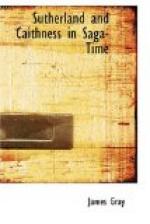By the above record, which is a regrant of the Strathnaver lands by Archebald Bishop of Moray in May 1269 to Reginald Chen II, not only is his marriage before that date to Mary daughter of Johanna by Freskin de Moravia proved, but the lands in Strathnaver are identifiable. They were “Langeval and Rossewal, tofftys de Dovyr, Achenedess, Clibr’, Ardovyr and Cornefern,” which now are known in part as Langdale, Rossal, Achness, Clibreck and Coire-na-fearn, while “tofftys” are “tofts,” and “Dovyr” and “Ardovyr” are respectively old Gaelic for “water” and for “upper water.” “Dovyr” would denote the River Naver and loch of that name, and “Ardovyr” would mean Loch Coire and the Mallard River, that is the “Abhain ’a Mhail Aird” of the Ordnance Map (whatever that may mean),[19] which rises in Loch Coire, and, after a course of six miles from its upper valley, falls about 330 feet below its source into the River Naver at Dalharrold. These lands of the Lady Johanna lay partly to the south of Loch Naver, extended southwards nearly to Ben Armine, and stretched westwards to Loch Vellich or Bealach and the Crask and Mudale, eastwards to Loch Truderscaig, and northwards down the valley of the Naver at least as far as Syre. Part of them, close to Achness,[30] is to this day known locally as Kerrow-na-Shein, or Chen’s Quarter, either after Johanna’s son-in-law, Sir Reginald Chen II, or after her grandson of the same name, the great “Morar na Shein,” about whom so many legends still survive in Cat. These lands in Strathnaver are roughly hatched on the map of Cat in this volume, and, as she gave them away in charitable trust, they probably formed only a small part of her whole estate after her marriage with Freskin de Moravia, which probably comprised the old Parish of Farr, now divided into Tongue, Farr, and Reay.
It is suggested that the ownership of these lands in Strathnaver and of the other upland territories in Halkirk and Latheron parishes, held by her descendants and sequels in all her estate, the Chens, connects the Lady Johanna with the family of Moddan “in dale” in Caithness and with Earl Ottar, and with Frakark and Audhild her niece, and that Johanna was entitled to these lands in their entirety in her own right as the sole descendant remaining in Scotland after 1232 of Harald Ungi’s younger surviving sister Ragnhild, possibly through her son Snaekoll by Gunni, and that Snaekoll was next heir to these lands before he went abroad, and either that he was Johanna’s father, or that she became Ragnhild’s heir in his place. In this way Johanna would have a good right, especially if Magnus, son of Gilchrist, had been compensated for his mother’s share by receiving a grant of South Caithness and its earldom, to receive a grant of the rest of the Harald Ungi half share of the Caithness earldom, lands previously held by Jarls and Earls St. Magnus and Erlend Thorfinn’s son or some lands of equal value, and the reason why she had such very large estates as those which she brought to her husband and the Chen family as their successors would be made clear. For she would have completed her title to a large share of the Erlend lands, and also to the Moddan lands which Gunni and Ragnhild had entered upon and held after the elder sister of Ragnhild had left Caithness on her marriage with Gilchrist Earl of Angus.




